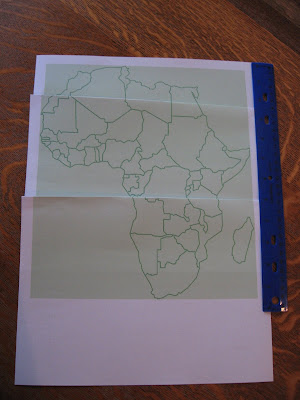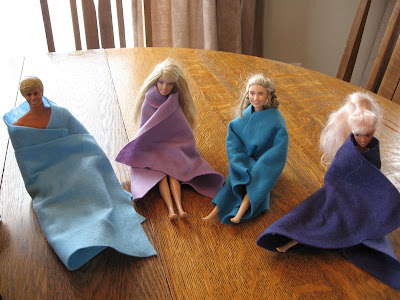
According to the fun loving folks at
A Magical Childhood, Shrove Tuesday (as pancake day is more officially known), has its roots in a tradition of families using up ingredients, such as eggs and sugar, restricted during Lent.
We don't observe Lent, but just by coincidence, I spent last weekend placing pancake themed books on hold at the library, thinking maybe we'd spend some time next weekend trying out the recipes included in them (there are a LOT of picture books with pancake recipes at the back). The first few of the books have already arrived in, so we had Tomie DePaola's
Pancakes for Breakfast already to go for this morning.

The book is typical DePaola, so a big hit in our house, and we thought the recipe (which you can view
here, with a sadly, negative review) was fantastic - so much for reviews.

The pancakes turned out light, and fluffy, if not quite as fluffy as the blueberry pancakes from
Wende and Harry Devlin's Old Black Witch, but delicious all the same, and when coupled with a few additional pancake themed picture books, made for a great kick off to the day.









All of the books above, except for the last two, promise perfect pancake recipes.
If you've already had breakfast, don't despair, there's plenty more to do on Pancake Day than just eating pancakes.
Activity Village,
Holiday Station, and
Stuff4Teaching all have several craft, and game suggestions, as well as links to printables, for last minute fun.
Update:Now that a few more of the books above have arrived in at the library, I thought I should give a quick update to this post.
As it turns out, while the original
Nate the Great story by Marjorie Weinman Sharmat, does contain a recipe for Nate's Pancakes (you can also find it,
here)
Nate the Great and the Lost List does not contain the recipe, but only the ingredient list, with a few fishy additions.
Thanks to Kendra for letting us know in the comments, that the first story contains the recipe.
Piggy's Pancake Parlor by David McPhail, and
Curious George Makes Pancakes by Margret & H.A. Rey do not contain recipes, either. Rather, George adds blueberry faces to already mixed batter on the griddle (something we tried without success), and Piggy divulges secret ingredients, that make his pancakes a success - nutmeg and love.

My father, who died long before my children were born, was a big fan of nutmeg in pancakes too, so we tried some in a batch of the buttermilk pancakes, we made from the recipe at the back of Tamson Weston's
Hey, Pancakes!Weston's recipe (which you can view,
here) was a big hit with the children. It made for very fluffy, tasty pancakes. And, everyone liked the addition of Piggy's secret ingredient except for me. I think I finally figured out why I never liked pancakes as a child.
We found one more children's book, with a pancake recipe, this time a blueberry pancake recipe, included too, Judith Bauer Stamper's All Aboard Math Reader,
Breakfast at Danny's Diner, a Book About Multiplication.


The recipe only makes six pancakes. As you might imagine, it is necessary for the characters in the story to multiply the ingredients for more pancakes. After looking the recipe over, we decided to stick with a single batch.
With no baking powder, baking soda, or sugar in the recipe I was pretty sure it wouldn't end up being the children's favorite, and it wasn't. That honor goes to Weston's recipe from Hey, Pancakes!, though my favorite is still Tomie DePaola's recipe from
Pancakes for Breakfast, above.
Of course, if you don't like pancakes, we found not just one, but eleven recipes for waffles, including -
Grandma's Waffles, Perfect Pumpkin Pecan Waffles, Crazy for Chocolate Waffles, Pa Pa Jack's Oatmeal Waffles, Bountiful Banana Nut Waffles, Lucille Victoria's Lemony-Blueberry Waffles, Peach Melba Waffles with Ice Cream and Raspberry Sauce, PB and J Waffle Sandwiches, Cheesy Mexican Cornbread Waffles, Betty's Berry Berry Berry Waffles, and Merry Christmas Waffles in Holly J. Williams
Waffles at Grandma's.

If only I hadn't picked this week to start counting calories again!
It's great to be a homeschooler.
 It's a sweet story of how a little can become a little bit more, when you invite friends to share what you have. I checked the book out originally as part of our pancake day celebrations. There is "pancake" recipe at the back, though it is really for more of a tortilla like flat bread, than an American style pancake.
It's a sweet story of how a little can become a little bit more, when you invite friends to share what you have. I checked the book out originally as part of our pancake day celebrations. There is "pancake" recipe at the back, though it is really for more of a tortilla like flat bread, than an American style pancake.






















 The book is typical DePaola, so a big hit in our house, and we thought the recipe (which you can view
The book is typical DePaola, so a big hit in our house, and we thought the recipe (which you can view 





























